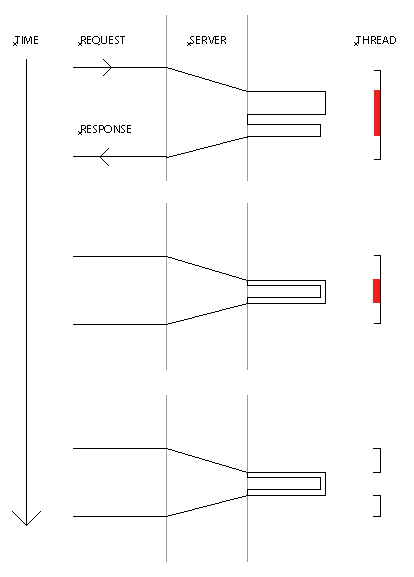-
Notifications
You must be signed in to change notification settings - Fork 9
Fuse
This requires latest rupy.
First, watch this part of a webinar explaining resource starvation: Konrad Malawski
This is how the current client/server tools work in a co-operative solution:
time <---------------- goes forth & back ------------------>
wait .... ..... .... .... ..... ....
loss ..... ..... (CPU)
+--------+ +---------+ +---------+ +---------+
| | -> | | ---+----> | | | |
| brow | | sync1 | | | sync2 | .. | serv2 |
| | <- | | <----+--- | | | |
+--------+ +---------+ | | +---------+ +---------+
| |
+---------+
| |
| serv1 |
| |
+---------+
-
brow=syncreq(browser) -
serv=syncres(database) -
sync=syncreq&res(old web-server)
The idea is to only wait in the network (no related IO-wait) and to wait for multiple things at the same time:
time <--------------- goes forth & back --------------->
wait .... .. .. ....
+--------+ +---------+ +---------+ +---------+
| | -> | | -+--> | | | |
| brow | | asyn1 | | | asyn2 | .. | serv2 |
| | <- | | <--+- | | | |
+--------+ +---------+ | | +---------+ +---------+
| |
| +---+
+---+ |
| |
+---------+
| |
| serv1 |
| |
+---------+
-
brow=syncreq(browser) -
serv=syncres(database) -
asyn=asynreq&res(FUSE)
For this we introduce a new concept; FUSE. With FUSE all threads asyn end-to-end or socket-to-socket if you will, they never wait for anything.
Another way to describe this is time and IO-wait shown in the graph below:
-
syncreq&res(old web-server) -
asynreq(netflix) -
asynreq&res(FUSE)
You can imagine that the compounded savings in terms of time and wait are huge, specially when the system grows in concurrency and depth. As a matter of fact, you can't scale at all without asyn req and with asyn req & res you're far better off.
If you want to use µSOA this is the most performant way to build your services network.
Another use case for this is our cluster database ROOT.
This example fuses data asyn from multiple servers to your browser ASAP on a raspberry pi with zero thread IO-wait:
// TODO: Improve latch.
public class Fuse extends Service {
public String path() { return "/fuse"; }
public void filter(final Event event) throws Event, Exception {
if(event.push()) {
Http[] http = (Http[]) event.query().get("http");
Output out = event.output();
int done = 0;
for(int i = 0; i < http.length; i++) {
if(http[i].print(out)) {
done++;
}
}
if(done == http.length) {
out.println("</body></html>");
out.finish();
}
out.flush();
}
else {
event.query().put("time", System.currentTimeMillis());
Http[] http = new Http[2];
http[0] = new Http("one", "root.rupy.se", "/node/user/key/TvaaS3cqJhQyK6sn", event);
http[1] = new Http("two", "root.rupy.se", "/meta/user/data/fuse", event);
for(int i = 0; i < http.length; i++) {
// The 10 at the end is very important.
// It means the socket will be kept alive
// for 10 seconds since last active.
// This is our Murphy's law solution.
event.daemon().client().send(http[i].host, http[i], 10);
}
event.query().put("http", http);
}
}
public static class Http extends Async.Work {
private String name;
private String host;
private String path;
private String body;
private Event event;
public Http(String name, String host, String path, Event event) {
super(event);
this.name = name;
this.host = host;
this.path = path;
}
public boolean print(Output out) throws Exception {
if(event.query().get(name) instanceof Http) {
long time = System.currentTimeMillis() - event.big("time");
System.out.println(" " + name + " " + time + " ms.");
out.println(body);
event.query().put(name, "done");
return true;
}
else if(event.query().get(name) instanceof String) {
return ((String) event.query().get(name)).equals("done");
}
return false;
}
public void send(Async.Call call) throws Exception {
call.get(path, "Host: " + host + "\r\n");
}
public void read(String host, String body) throws Exception {
this.body = body;
event.query().put(name, this);
System.out.println(" " + name + " success " + event.reply().wakeup(true));
}
public void fail(String host, Exception e) throws Exception {
if(e instanceof Async.Timeout) {
System.out.println(" " + e);
event.daemon().client().send(host, this, 10);
}
else {
e.printStackTrace();
event.query().put("response", e.toString());
System.out.println(" " + name + " failure " + event.reply().wakeup(true));
}
}
};
}




